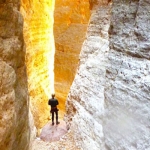 Grand Canyon National Park is replete with small tributaries and deep, narrow slot canyons that funnel into the main gorge. Canyoneering into these canyons is a challenging adventure through some of the most rugged and remote terrain Grand Canyon has to offer. Rescues are difficult and sometimes even impossible. While dazzling surprises abound for those with advanced technical skills and a strong determination, canyoneers must be in good physical condition and prepared to survive on their own. Special precautions must be taken to minimize the risk of flash floods, hypothermia, rock falls, and equipment failure.
Grand Canyon National Park is replete with small tributaries and deep, narrow slot canyons that funnel into the main gorge. Canyoneering into these canyons is a challenging adventure through some of the most rugged and remote terrain Grand Canyon has to offer. Rescues are difficult and sometimes even impossible. While dazzling surprises abound for those with advanced technical skills and a strong determination, canyoneers must be in good physical condition and prepared to survive on their own. Special precautions must be taken to minimize the risk of flash floods, hypothermia, rock falls, and equipment failure.
Permits
Overnight trips in Grand Canyon National Park require a backcountry permit. Trips utilizing packrafts require a permit – even day trips. Permits can be obtained from the Backcountry Information Center. For more information: GCNP Backcountry Permits
Etiquette
Exercise Common Courtesy. Let faster groups pass if your group is moving at a slow pace. If you plan to exit a slot via packraft, avoid camping on large beaches. Packrafts can use small beaches unsuitable for large raft groups.
Make Room for Wildlife. Narrow canyons often attract wildlife. Avoid cornering animals, such as bighorn sheep and rattlesnakes, in canyons. Move slowly and give wildlife enough space to retreat. Some animals will charge or strike if aggravated. Many side canyons provide habitat for endangered owls. Travel quietly to avoid disturbing the owls. Report unusual wildlife sightings to the park.
Choose a Good Anchor. Natural anchors are abundant and must be used at all times. Ensure that you are proficient at rigging from natural anchors before entering a slot canyon. The placement of new bolts is prohibited. There should be no more than one piece of webbing on an anchor. If you replace webbing, carry the used webbing out. Use black webbing for anchors. Black blends in with natural surroundings. Minimize the amount of webbing required by selecting the safest anchor closest to the rappe!.
Dispose of Human Waste Properly. Carry human waste disposal bags for solid human waste. Pack waste bags out of the canyon and dispose of them properly. Pack out all toilet paper. Additionally, avoid polluting potholes and shallow water resources with urine. When possible, urinate in the Colorado River, but avoid urinating on beaches or in small streams.
Be Prepared
Your Safety is Your Responsibility. Canyoneering has inherent risks that require participants to be in good physical condition. Canyoneers must have the skills and equipment needed for self-rescue. Most slot canyons at Grand Canyon National Park are located in rugged, remote areas making rescues extremely difficult and sometimes even impossible. Rescue is not a certainty. Canyoneers assume complete responsibility for their own safety. Bring a map, compass, and route description, and follow them carefully. Never enter a slot canyon if you lack full and complete information for the technical descent.
Always leave detailed information about your trip with someone who will not be joining you. Instruct this person to contact Grand Canyon dispatch at (928) 638-7805 if you do not return by a specified time. Satellite phones and SPOT devices do not work inside slot canyons and are unreliable if you become injured or trapped. Evaluate the weather forecast for flash flood potential before your trip and pay attention to changing conditions while in the canyon. You cannot outrun a flash flood. If storm clouds threaten, get to high ground and stay there until the storm passes.
Always carry enough gear to deal with emergency situations. Bring extra food, clothing, and water for emergency situations. Canyons change with each flash flood. You must be prepared to solve problems not disclosed in route descriptions. Include ascenders and extra descenders in your pack and have the ability to belay less experienced members of your group.
Only choose slot canyons that are compatible with your skill level. Make sure you choose an exit route that is compatible with your skill level too. If a packraft is utilized, be sure you have the skills to traverse the Colorado River and a permit from the River Permits Office if floating more than five river miles.
Rock falls are a serious risk. Helmets are essential. Many slot canyons contain deep, cold pools requiring a wetsuit or dry suit for thermal protection. Beware of hypothermia, even in the heat of summer. Never descend a slot canyon solo. Partner assists are often necessary in difficult spots.
